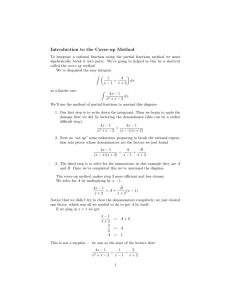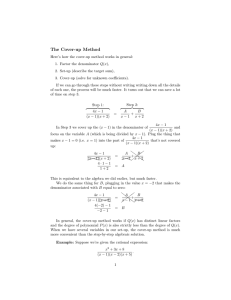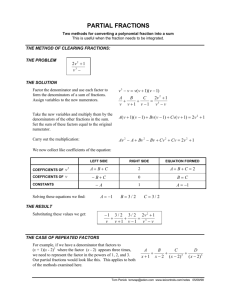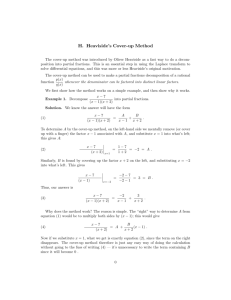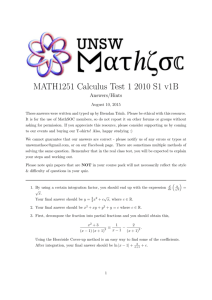x x x x x x x x x x x x x A B C x x x x x x x x A x x B x x C x x x x x
advertisement
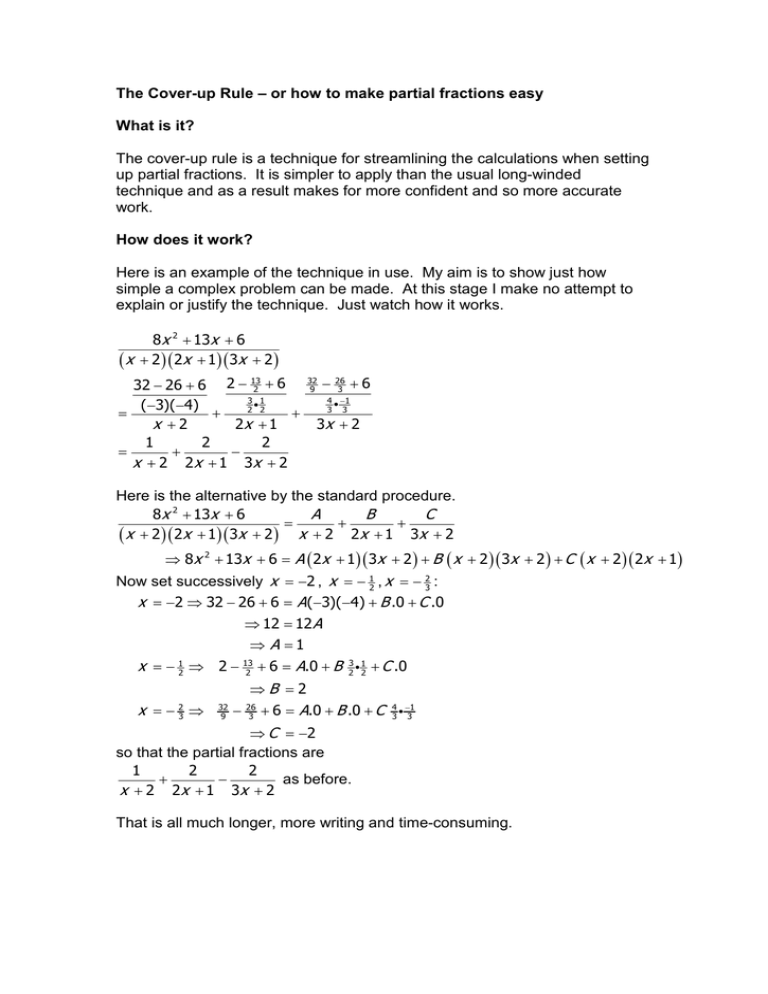
The Cover-up Rule – or how to make partial fractions easy What is it? The cover-up rule is a technique for streamlining the calculations when setting up partial fractions. It is simpler to apply than the usual long-winded technique and as a result makes for more confident and so more accurate work. How does it work? Here is an example of the technique in use. My aim is to show just how simple a complex problem can be made. At this stage I make no attempt to explain or justify the technique. Just watch how it works. 8x 2 + 13x + 6 ( x + 2 )( 2x + 1)( 3x + 2 ) 32 − 26 + 6 2 − 132 + 6 3 1 i (−3)(−4) 2 2 = + + x +2 2x + 1 1 2 2 = + − x + 2 2 x + 1 3x + 2 − 263 + 6 4 −1 i 3 3 3x + 2 32 9 Here is the alternative by the standard procedure. 8x 2 + 13x + 6 A B C = + + ( x + 2 )( 2x + 1)( 3x + 2 ) x + 2 2x + 1 3x + 2 ⇒ 8x 2 + 13x + 6 = A ( 2x + 1)( 3x + 2 ) + B ( x + 2 )( 3x + 2 ) + C ( x + 2 )( 2x + 1) Now set successively x = −2 , x = − 12 , x = − 23 : x = −2 ⇒ 32 − 26 + 6 = A (−3)(−4) + B .0 + C .0 ⇒ 12 = 12 A ⇒ A =1 x = − 12 ⇒ 2 − 132 + 6 = A.0 + B 23 i 12 + C .0 ⇒B =2 x = − 23 ⇒ 32 9 − 26 3 + 6 = A.0 + B .0 + C 43 i −31 ⇒ C = −2 so that the partial fractions are 1 2 2 + − as before. x + 2 2 x + 1 3x + 2 That is all much longer, more writing and time-consuming. So how do you do it? The cover-up rule can be applied to calculate the coefficients for simple linear factors of the denominator. Here all three are simple. Here is the initial set of calculations again. Take the first one, x + 2. What is the value which makes that bracket (x + 2) zero? x = -2. Cover up the factor (x + 2) in the original expression and put x = -2 everywhere else. 8x 2 + 13x + 6 ( x + 2 )( 2x + 1)( 3x + 2 ) 32 − 26 + 6 (−3)(−4) = + ... + ... x +2 1 = + ... − ... x +2 8x + 13x + 6 = A ( 2x + 1)( 3x + 2 ) + ... 2 x = −2 ⇒ 32 − 26 + 6 = A (−3)(−4) + B .0 + C .0 ⇒ 12 = 12 A ⇒ A =1 8x 2 + 13x + 6 ( x + 2 )( 2x + 1)( 3x + 2 ) x =−2 32 − 26 + 6 =1 (−3)(−4) That is the value to be placed over (x + 2). which evaluates to In the identity used in the longwinded method, repeated here, the same value x = -2 is used to get an equation for A. It works because the precisely that substitution results in B and C making no contribution by virtue of the 0’s which follow them. The calculation for A is essentially what we have just carried out but much more slickly by the cover-up rule. This justification similarly works for the evaluation of both B and C. The crux of the argument is that the calculations used in the cover-up method are exactly the same bits of arithmetic as in the long-winded method, but presented much more efficiently. Let us look at two more examples to prove the point. 2x 2 + 39x + 12 ( 2x 1 2 = = + 1) ( x − 3 ) 2 + −39 2 −7 2 ( 2x + 12 + 1) 2 ( 2x + 1) 2 2 + 18 + 117 + 12 B 49 + + 2x + 1 x −3 3 B + 2x + 1 x − 3 Now set x = 0 in the identity just established: − 4 = 2 + B −1 ⇒ B = −5 So now we have finally 2x 2 + 39x + 12 ( 2x = + 1) ( x − 3 ) 2 2 ( 2x + 1) 2 − 5 3 + 2x + 1 x − 3 When we have a multiple linear factor 2 such as ( 2x + 1) here, we can use the cover up rule to determine the coefficient over its highest power as well as for the simple linear factor x − 3 . We cannot use it for B. (Nor can it be used to find the coefficients in a case such as Px + Q .) x 2 +1 The cover-up rule has eliminated much of the work and finding B has become very easy. The justification for the cover-up rule to find the coefficient over (2x + 1)2 is similar to that in the case of simple factors. Just cross-multiply and scrutinise the arithmetic involved in the long-winded method. Another example in a different context. 3 ∫ ( x + 1)( x − 2 )dx 3 3 −3 = ∫ + 3 dx x +1 x − 2 (by the cover-up rule) = − ln x + 1 + ln x − 2 + c = ln A (x − 2) x +1 Here the cover-up rule is not just slick; it avoids breaking out of the line of development of the integral while the partial fractions are established. A final point Now consider a more complex example. The calculation below is WRONG – it shows a standard mistake! x 4 + 3x + 1 (x + 2 )( x − 1) 2 11 5 B 9 3 = + + 2 ( x + 2 ) ( x − 1) x − 1 1 11 5 = + −B 2 18 3 11 5 1 + + B = 18 3 2 11 + 30 + 9 = 18 25 = 9 11 5 25 = + + 2 9 ( x + 2 ) 3 ( x − 1) 9 ( x − 1) This is wrong because we have forgotten to divide out first, since the numerator is of greater order than the denominator. But as we shall see it has an interesting bearing on the correct solution. Still WRONG! But useful as we shall see. Having done it the wrong way we now present it the right way. x 4 + 3x + 1 (x = + 2 )( x − 1) 2 x 4 + 3x + 1 ( x + 2 ) ( x 2 − 2x + 1) x 4 + 3x + 1 x 3 − 2x 2 + x + 2x 2 − 4 x + 2 x 4 + 3x + 1 = 3 x − 3x + 2 ( x 3 − 3x + 2 ) x + 3x 2 − 2x + 3x + 1 We multiply out the denominator as a preliminary to long-division. = = =x + =x + x 3 − 3x + 2 3x 2 + x + 1 x 3 − 3x + 2 3x 2 + x + 1 (x + 2 )( x − 1) 2 11 5 B 9 3 =x + + + 2 ( x + 2 ) ( x − 1) x − 1 But it is clear that the quotient is just x, so since long-division is to be avoided whenever possible we rearrange the numerator to squeeze out the remainder. Now for the partial fractions. Notice that the arithmetic for the coefficients is identical here to the wrong version above. Now set x = 0 in the identity. 1 11 5 =0+ + −B 2 18 3 11 5 1 + + B = 18 3 2 11 + 30 + 9 = 18 25 = 9 11 5 25 =x + + + 2 9 ( x + 2 ) 3 ( x − 1) 9 ( x − 1) This phenomenon means that it is easy to check whether a mistake has been made at the multiply-out and long division stage. If the coefficients obtained by the cover-up rule by the bogus method – you can do it in your head! - do not match the final answers by the correct method there has to be a mistake somewhere. As long division is a very accident-prone procedure this is a very useful check on accuracy!
